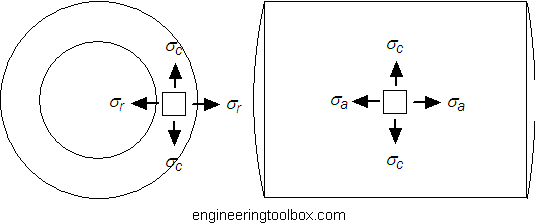Thick Walled Pressure Vessels¶

Image: Engineering Toolbox.
A thick walled pressure vessel is generally considered to be one whose walls are greater than about 1/10 or 1/20 of the radius of the vessel. The formulas provided below are for reference and calculation, but before constructing a real pressure vessel you should check with an engineer. The information is provided for your reference. Remember that a catastrophic failure of a vessel could result in serious injury or death.
Axial Stress¶
\(\sigma_a = \frac{p_i r_i^2 - p_o r_o^2}{r_o^2-r_i^2}\)
Circumferential (Hoop) Stress¶
\(\sigma_c = \frac{p_i r_i^2 - p_o r_o^2}{r_o^2 - r_i^2} - \frac{r_i^2 r_o^2(p_o - p_i)}{r^2(r_o^2-r_i^2)}\)
Radial Stress¶
\(\sigma_r = \frac{p_i r_i^2 - p_o r_o^2}{r_o^2-r_i^2} + \frac{r_i^2 r_o^2(p_o-P_i)}{r^2(r_o^2-r_i^2)}\)
Nomenclature¶
- \(\sigma_a\) = Axial Stress
- \(\sigma_c\) = Circumgerential (Hoop) Stress
- \(\sigma_r\) = Radial Stress
- \(p_i\) = Internal Pressure
- \(p_o\) = External Pressure
- \(r_i\) = Internal Radius
- \(r_o\) = External Radius
- \(r\) = Radius to a point in the wall